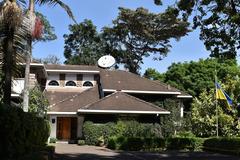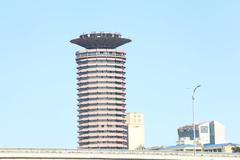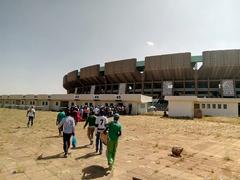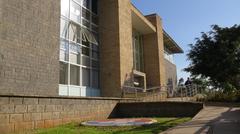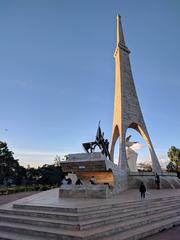Comprehensive Guide to Visiting Station Road, Nairobi, Kenya
Date: 24/07/2024
Introduction
Station Road in Nairobi, now officially known as Moi Avenue, is a historical and cultural artery that reflects the evolution of Kenya’s capital city. Established in the late 19th century, Station Road was initially constructed to serve the Nairobi Railway Station, a pivotal point in the development of Nairobi as a colonial administrative hub (Wikipedia). Over the decades, this road has witnessed significant transformations, from its early days as a bustling colonial thoroughfare, through its renaming to Government Road, and finally to its current designation as Moi Avenue in honor of Kenya’s second president, Daniel arap Moi. Along its length, visitors can explore an array of historical landmarks, including Jeevanjee Gardens, the Khoja Mosque, and the Tom Mboya Monument, each contributing to the rich tapestry of Nairobi’s history (Wikipedia; Wikipedia). Today, Station Road remains a vital part of Nairobi’s Central Business District, lined with a mix of historical buildings, modern commercial establishments, and cultural landmarks. This guide provides an in-depth look at the history, visitor tips, and must-see attractions along Station Road, ensuring a memorable and insightful visit.
Table of Contents
- Introduction
- Early Beginnings
- Government Road Era
- Post-Independence Transformation
- Historical Landmarks
- Modern-Day Significance
- Visitor Tips
- Attractions and Activities
- Practical Information
- FAQ Section
- Conclusion
Exploring Moi Avenue - History, Landmarks, and Visitor Tips in Nairobi
Early Beginnings
Moi Avenue, originally known as Station Road, is one of the oldest and most significant roads in Nairobi, Kenya. Initially named First Station Road, it was constructed to serve the Nairobi Railway Station, which was a pivotal point in the development of the city. The road quickly became a central artery for government offices and commercial activities, reflecting Nairobi’s burgeoning role as a colonial administrative hub.
Government Road Era
In 1901, the road was renamed Government Road, a title it held for several decades. This period marked significant growth and development along the road, with numerous government buildings and commercial establishments springing up. The road became synonymous with the administrative and economic activities of the colonial government. Landmarks such as the Jeevanjee Gardens and the Khoja Mosque were established during this era, adding to the road’s historical and cultural significance (Wikipedia).
Post-Independence Transformation
Following Kenya’s independence in 1963, Government Road was renamed Moi Avenue in honor of Daniel arap Moi, who served as the country’s second president. This renaming was part of a broader effort to Africanize place names and reflect the new national identity. The road continued to be a central hub for commercial and administrative activities, with landmarks such as the Hilton Park and Moi University becoming prominent features (Wikipedia).
Historical Landmarks
Jeevanjee Gardens
Jeevanjee Gardens, located along Moi Avenue, is one of Nairobi’s oldest public parks. Donated by Alibhai Mulla Jeevanjee in 1906, the gardens have served as a recreational space for Nairobi’s residents for over a century. The park is a testament to the philanthropic efforts of Jeevanjee, an influential figure in Nairobi’s early development (Wikipedia).
Khoja Mosque
The Khoja Mosque, also known as the Nairobi Town Jamatkhana, is another significant landmark on Moi Avenue. Established in the early 20th century, the mosque has been a center for the Ismaili Muslim community in Nairobi. Its architectural design and historical significance make it a notable feature of the road (Wikipedia).
Tom Mboya Monument
One of the most poignant landmarks on Moi Avenue is the Tom Mboya Monument. Erected in memory of the prominent Kenyan politician Tom Mboya, who was assassinated on Government Road in 1969, the monument stands as a reminder of Kenya’s turbulent political history. Mboya was a key figure in Kenya’s struggle for independence and his death marked a significant moment in the country’s post-independence history (Wikipedia).
Modern-Day Significance
Today, Moi Avenue remains a bustling thoroughfare in Nairobi’s Central Business District (CBD). It is lined with a mix of historical buildings, modern commercial establishments, and cultural landmarks. The road continues to be a vital part of Nairobi’s urban landscape, reflecting the city’s growth and evolution over the past century.
Visitor Tips
Navigating Moi Avenue
Visitors to Moi Avenue can explore a variety of historical and cultural sites. The road is well-connected by public transportation, including buses and taxis, making it easily accessible from different parts of the city. Walking tours are also a popular way to explore the area, allowing visitors to take in the sights and sounds of this vibrant street.
Safety Considerations
As with any major urban area, visitors should be mindful of their surroundings and take standard safety precautions. It is advisable to avoid displaying valuable items and to be cautious when navigating crowded areas. The presence of landmarks such as the Hilton Park and Moi University ensures that there are always people around, contributing to the overall safety of the area.
Best Times to Visit
The best time to visit Moi Avenue is during the day when the shops, cafes, and historical sites are open. Early mornings and late afternoons are particularly pleasant times to explore, as the weather is usually mild and the streets are less crowded. Special events and public holidays can also offer unique opportunities to experience the local culture and festivities.
Additional Visitor Information
Public Transportation
Moi Avenue is easily accessible through Nairobi’s extensive public transportation network. Buses and taxis are readily available, providing convenient options for visitors.
Walking Tours
Walking tours are highly recommended for a more immersive experience. Guided tours are available and provide in-depth insights into the history and significance of various landmarks.
Ticket Prices and Visiting Hours
Most landmarks on Moi Avenue, such as Jeevanjee Gardens and the Tom Mboya Monument, are open to the public free of charge. However, it is advisable to check the specific visiting hours for each site in advance.
Nearby Attractions
Visitors can also explore other nearby historical sites and attractions such as the Nairobi National Museum and the Kenyatta International Conference Centre, both within a short distance from Moi Avenue.
Accessibility Information
Moi Avenue is generally accessible for visitors with mobility challenges. Many of the landmarks and public spaces have provisions for wheelchair access.
Frequently Asked Questions
Q - What are the visiting hours for Moi Avenue landmarks? A - Most landmarks are open during the day, but it is best to check specific visiting hours in advance.
Q - How to get to Moi Avenue? A - Moi Avenue is well-connected by public transportation, including buses and taxis.
Q - What are the safety tips for visiting Moi Avenue? A - Be mindful of your surroundings, avoid displaying valuables, and stay cautious in crowded areas.
Conclusion
Moi Avenue, formerly known as Station Road and Government Road, is a historical and cultural artery in Nairobi. Its evolution from a colonial administrative hub to a modern commercial center reflects the broader changes in Nairobi and Kenya as a whole. Visitors to Moi Avenue can explore a rich tapestry of historical landmarks, cultural sites, and modern amenities, making it a must-visit destination in Nairobi.
Conclusion
Station Road, or Moi Avenue, stands as a testament to Nairobi’s rich historical and cultural heritage. From its origins as a colonial railway hub to its current status as a bustling commercial and cultural center, the road encapsulates the dynamic evolution of the city. Visitors to Station Road can immerse themselves in Nairobi’s past by exploring landmarks like the Nairobi Railway Museum, Jeevanjee Gardens, and the Khoja Mosque, each offering unique insights into the city’s development and cultural diversity (Atlas Obscura; Travel with a Pen). The practical tips and visitor information provided in this guide ensure a safe and enjoyable experience, whether you’re exploring the historical sites, shopping at local markets, or indulging in Nairobi’s diverse culinary scene. As you walk along Station Road, you’ll not only witness the architectural grandeur and historical significance but also feel the vibrant pulse of Nairobi’s present-day life. For a deeper engagement and more comprehensive travel experiences, consider checking out related posts, downloading the Audiala mobile app, or following our social media updates.
References
- Wikipedia. (n.d.). Moi Avenue (Nairobi). Retrieved from https://en.wikipedia.org/wiki/Moi_Avenue_(Nairobi)
- Wikipedia. (n.d.). Jeevanjee Gardens. Retrieved from https://en.wikipedia.org/wiki/Jeevanjee_Gardens
- Wikipedia. (n.d.). Tom Mboya. Retrieved from https://en.wikipedia.org/wiki/Tom_Mboya
- Atlas Obscura. (n.d.). Nairobi Railway Museum. Retrieved from https://www.atlasobscura.com/places/nairobi-railway-museum
- Travel with a Pen. (n.d.). Best Fun Places to Visit in Nairobi. Retrieved from https://www.travelwithapen.com/best-fun-places-to-visit-in-nairobi/
